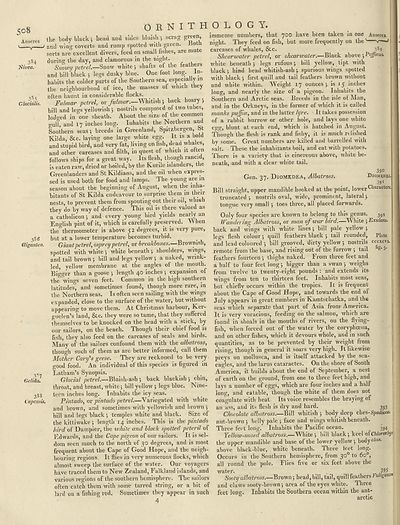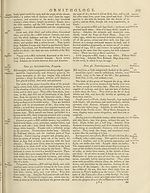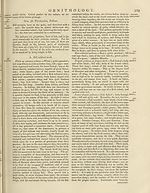Encyclopaedia Britannica > Volume 15, NIC-PAR
(562) Page 508
Download files
Complete book:
Individual page:
Thumbnail gallery: Grid view | List view

ORNITHOLOGY.
334
Nivca.
3 S 5
Glacialis.
3S5
Ctigantea.
Gehda.
388
Capensis,
the body blackj head and sides bluish', scrag green,
and wing coverts and rump spotted with green. Jsoth
sorts are excellent divers, feed on small fishes, are mute
during the day, and clamorous in the night.
Snowy petrel.—Snow white j shafts of the leatheis
and bill black ; legs dusky blue. One loot long. In¬
habits the colder parts of the Southern sea, especially in
the neighbourhood of ice, the masses of which t icy
often haunt in considerable flocks.
Fulmar petrel, or fulmar.—Whitish j back hoary }
bill and legs yellowish j nostrils composed of two tubes,
lodged in one sheath. About the size of the common
gull, and 17 inches long. Inhabits the Northern and
Southern seas *, breeds in Greenland, Spitzbergen, St
Kilda, &c. laying one large white egg. It is a bold
and stupid bird, and very fat, living on fish, dead whales,
and other carcases and filth, in quest of which it often
follows ships for a great way. Its flesh, though rancid,
is eaten raw, dried or boiled, by the Kurile islanders, the
Greenlanders and St Kildians, and the oil when expres¬
sed is used both for food and lamps. The young are m
season about the beginning of August, when the inha¬
bitants of St Kilda endeavour to surprise them in their
nests, to prevent them from spouting out their oil, which
they do by way of defence. This oil is there valued as
a catholicon} and every young bird yields nearly an
English pint of it, which is carefully preserved. When
the thermometer is above 52 degrees, it is very pure,
but at a lower temperature becomes turbid.
Giant petrel, osprey petrel, or brcakbones.—Brownish,
spotted with white } white beneath ; shoulders, wings,
and tail brown ; bill and legs yellow *, a naked, wrink¬
led, yellow membrane at the angles of the mouth.
Bigger than a goose j length 40 inches ; expansion of
the wings seven feet. Common in the high southern
latitudes, and sometimes found, though more rare, in
the Northern seas. Is often seen sailing with the wings
expanded, close to the surface of the water, but without
appearing to move them. At Christmas harbour, Ker¬
guelen’s land, &c. they were so tame, that they suffered
themselves to be knocked on the head with a stick, by
our sailors, on the beach. Though their chief food is
fish, they also feed on the carcases of seals and birds.
Many of the sailors confound them with the albatross,
though such of them as are better informed, call them
Mother Cary's geese. They are reckoned to be very
good food. An individual of this species is figured in
Latham’s Synopsis.
Glacial petrel.—Bluish-ash j back blackish 5 chin,
throat, and breast, white; bill yellow ; legs blue. Nine¬
teen inches long. Inhabits the icy seas.
Pintado, or pintado petrel.—Variegated with white
and brown, and sometimes w ith yellowish and brown ;
bill and legs black; temples white and black. Size of
the kittiwake ; length 14 inches. This is i\\e. pintado
bird of Dampier, the white and black spotted petenl of
Edwards, and the Cape pigeon of our sailors. It is sel¬
dom seen much to the north of 30 degrees, and is most
frequent about the Cape of Good Hope, and the neigh¬
bouring regions It flies in very numerous flocks, which
almost sweep the surface of the water. Our voyagers
have traced them to New Zealand, Falkland islands, and
various regions of the southern hemisphere. The sailors
often catch them with some tarred string, or a bit of
laid on a fishing rod. Sometimes they appear in such
4
immense numbers, that 730 have been taken in one An sere*
night. They feed on fish, but more frequently on the'
carcases of whales, &c. 389
Shearwater petrel, or shearwater.—Black above ;Pejlinwi
white beneath; legs rufous; bill yellow, tipt with
black ; hind head whitish-ash ; spurious wings spotted
with black; first quill and tail feathers brown without
and white within. Weight 17 ounces; is 15 inches
long, and nearly the size of a pigeon. Inhabits the
Southern and Arctic seas. Breeds in the isle ot Man,
and in the Orkneys, in the former of which it is called
manks puffin, and in the latter lyre. It takes possession
of a rabbit burrow or other hole, and lays one white
egg, blunt at each end, which is hatched in August.
Though the flesh is rank and fishy, it is much rt fished
by some. Great numbers are killed and barrelled with
salt. These the inhabitants boil, and eat with potatoes.
There is a variety that is cinereous above, white be¬
neath, and with a clear white tail.
Gen. 37. Diomedea, Albatross.
39°
Diomedea,
391
Bill straight, upper mandible hooked at the point, lowerCliaracters-
truncated ; nostrils oval, wide, prominent, lateral;
tongue very small ; toes three, all placed lorwards.
Only four species are known to belong to this genus. 392
Wandering Albatross, or man of war bird.—White ; Exulans.
back and wings with white lines; bill pale yellow ;
legs flesh colour; quill feathers black ; tail rounded, Plate
and lead coloured ; bill grooved, dirty yellow ; nostrils cccxcvi.
remote from the base, and rising out of the furrow ; tail
feathers fourteen ; thighs naked. From three feet and
a half to four feet long; bigger than a swan; weighs
from twelve to twenty-eight pounds : and extends its
wings from ten to thirteen feet. Inhabits most seas,
but chiefly occurs within the tropics. It is frequent
about the Cape of Good Hope, and towards the end of
July appears in great numbers in Kamtschatka, and the
seas which separate that part of Asia from America.
It is very voracious, feeding on the salmon, which are
found in shoals in the mouths of rivers, on the flying-
fish, when forced out of the water by the coryphoena,
and on other fishes, which it devours whole, and in such
quantities, as to be prevented by their weight from
rising, though in general it soars very high. It likewise
preys on mollusca, and is itself attacked by the sea-
eagles, and the larus cataractes. On the shore ot South
America, it builds about the end of September, a nest
of earth on the ground, from one to three leet high, ami
lays a number of eggs, which are four inches and a half
long, and eatable, though the white of them does not
coagulate with heat Its voice resembles the braying ot
an ass, and its flesh is dry and hard. 393
Chocolate albatross.—Bill whitish ; body deep dies-
nut-brown ; belly pale ; face and wings whitish beneath.
Three feet long. Inhabits the Pacific ocean. 394
Yellow-nosed albatross.—ViVxte ; bill black; keel oiChlororhy
the upper mandible and base of the lower yellow; body ^os-
above black-blue, white beneath. Three feet long.
Occurs in the Southern hemisphere, from 30° to 6o°,
all round the pole. Flies five or six feet above the
water. „ # , 895
Sooty albatross.—Brown; head, bill, tail, quill feathers J*
and claws sooty-brown; area of the eyes white. Three
feet long. Inhabits the Southern ocean within the ant¬
arctic
334
Nivca.
3 S 5
Glacialis.
3S5
Ctigantea.
Gehda.
388
Capensis,
the body blackj head and sides bluish', scrag green,
and wing coverts and rump spotted with green. Jsoth
sorts are excellent divers, feed on small fishes, are mute
during the day, and clamorous in the night.
Snowy petrel.—Snow white j shafts of the leatheis
and bill black ; legs dusky blue. One loot long. In¬
habits the colder parts of the Southern sea, especially in
the neighbourhood of ice, the masses of which t icy
often haunt in considerable flocks.
Fulmar petrel, or fulmar.—Whitish j back hoary }
bill and legs yellowish j nostrils composed of two tubes,
lodged in one sheath. About the size of the common
gull, and 17 inches long. Inhabits the Northern and
Southern seas *, breeds in Greenland, Spitzbergen, St
Kilda, &c. laying one large white egg. It is a bold
and stupid bird, and very fat, living on fish, dead whales,
and other carcases and filth, in quest of which it often
follows ships for a great way. Its flesh, though rancid,
is eaten raw, dried or boiled, by the Kurile islanders, the
Greenlanders and St Kildians, and the oil when expres¬
sed is used both for food and lamps. The young are m
season about the beginning of August, when the inha¬
bitants of St Kilda endeavour to surprise them in their
nests, to prevent them from spouting out their oil, which
they do by way of defence. This oil is there valued as
a catholicon} and every young bird yields nearly an
English pint of it, which is carefully preserved. When
the thermometer is above 52 degrees, it is very pure,
but at a lower temperature becomes turbid.
Giant petrel, osprey petrel, or brcakbones.—Brownish,
spotted with white } white beneath ; shoulders, wings,
and tail brown ; bill and legs yellow *, a naked, wrink¬
led, yellow membrane at the angles of the mouth.
Bigger than a goose j length 40 inches ; expansion of
the wings seven feet. Common in the high southern
latitudes, and sometimes found, though more rare, in
the Northern seas. Is often seen sailing with the wings
expanded, close to the surface of the water, but without
appearing to move them. At Christmas harbour, Ker¬
guelen’s land, &c. they were so tame, that they suffered
themselves to be knocked on the head with a stick, by
our sailors, on the beach. Though their chief food is
fish, they also feed on the carcases of seals and birds.
Many of the sailors confound them with the albatross,
though such of them as are better informed, call them
Mother Cary's geese. They are reckoned to be very
good food. An individual of this species is figured in
Latham’s Synopsis.
Glacial petrel.—Bluish-ash j back blackish 5 chin,
throat, and breast, white; bill yellow ; legs blue. Nine¬
teen inches long. Inhabits the icy seas.
Pintado, or pintado petrel.—Variegated with white
and brown, and sometimes w ith yellowish and brown ;
bill and legs black; temples white and black. Size of
the kittiwake ; length 14 inches. This is i\\e. pintado
bird of Dampier, the white and black spotted petenl of
Edwards, and the Cape pigeon of our sailors. It is sel¬
dom seen much to the north of 30 degrees, and is most
frequent about the Cape of Good Hope, and the neigh¬
bouring regions It flies in very numerous flocks, which
almost sweep the surface of the water. Our voyagers
have traced them to New Zealand, Falkland islands, and
various regions of the southern hemisphere. The sailors
often catch them with some tarred string, or a bit of
laid on a fishing rod. Sometimes they appear in such
4
immense numbers, that 730 have been taken in one An sere*
night. They feed on fish, but more frequently on the'
carcases of whales, &c. 389
Shearwater petrel, or shearwater.—Black above ;Pejlinwi
white beneath; legs rufous; bill yellow, tipt with
black ; hind head whitish-ash ; spurious wings spotted
with black; first quill and tail feathers brown without
and white within. Weight 17 ounces; is 15 inches
long, and nearly the size of a pigeon. Inhabits the
Southern and Arctic seas. Breeds in the isle ot Man,
and in the Orkneys, in the former of which it is called
manks puffin, and in the latter lyre. It takes possession
of a rabbit burrow or other hole, and lays one white
egg, blunt at each end, which is hatched in August.
Though the flesh is rank and fishy, it is much rt fished
by some. Great numbers are killed and barrelled with
salt. These the inhabitants boil, and eat with potatoes.
There is a variety that is cinereous above, white be¬
neath, and with a clear white tail.
Gen. 37. Diomedea, Albatross.
39°
Diomedea,
391
Bill straight, upper mandible hooked at the point, lowerCliaracters-
truncated ; nostrils oval, wide, prominent, lateral;
tongue very small ; toes three, all placed lorwards.
Only four species are known to belong to this genus. 392
Wandering Albatross, or man of war bird.—White ; Exulans.
back and wings with white lines; bill pale yellow ;
legs flesh colour; quill feathers black ; tail rounded, Plate
and lead coloured ; bill grooved, dirty yellow ; nostrils cccxcvi.
remote from the base, and rising out of the furrow ; tail
feathers fourteen ; thighs naked. From three feet and
a half to four feet long; bigger than a swan; weighs
from twelve to twenty-eight pounds : and extends its
wings from ten to thirteen feet. Inhabits most seas,
but chiefly occurs within the tropics. It is frequent
about the Cape of Good Hope, and towards the end of
July appears in great numbers in Kamtschatka, and the
seas which separate that part of Asia from America.
It is very voracious, feeding on the salmon, which are
found in shoals in the mouths of rivers, on the flying-
fish, when forced out of the water by the coryphoena,
and on other fishes, which it devours whole, and in such
quantities, as to be prevented by their weight from
rising, though in general it soars very high. It likewise
preys on mollusca, and is itself attacked by the sea-
eagles, and the larus cataractes. On the shore ot South
America, it builds about the end of September, a nest
of earth on the ground, from one to three leet high, ami
lays a number of eggs, which are four inches and a half
long, and eatable, though the white of them does not
coagulate with heat Its voice resembles the braying ot
an ass, and its flesh is dry and hard. 393
Chocolate albatross.—Bill whitish ; body deep dies-
nut-brown ; belly pale ; face and wings whitish beneath.
Three feet long. Inhabits the Pacific ocean. 394
Yellow-nosed albatross.—ViVxte ; bill black; keel oiChlororhy
the upper mandible and base of the lower yellow; body ^os-
above black-blue, white beneath. Three feet long.
Occurs in the Southern hemisphere, from 30° to 6o°,
all round the pole. Flies five or six feet above the
water. „ # , 895
Sooty albatross.—Brown; head, bill, tail, quill feathers J*
and claws sooty-brown; area of the eyes white. Three
feet long. Inhabits the Southern ocean within the ant¬
arctic
Set display mode to:
![]() Universal Viewer |
Universal Viewer | ![]() Mirador |
Large image | Transcription
Mirador |
Large image | Transcription
Images and transcriptions on this page, including medium image downloads, may be used under the Creative Commons Attribution 4.0 International Licence unless otherwise stated. ![]()
| Encyclopaedia Britannica > Encyclopaedia Britannica > Volume 15, NIC-PAR > (562) Page 508 |
|---|
| Permanent URL | https://digital.nls.uk/192589004 |
|---|
| Attribution and copyright: |
|
|---|
| Shelfmark | EB.11 |
|---|---|
| Description | Ten editions of 'Encyclopaedia Britannica', issued from 1768-1903, in 231 volumes. Originally issued in 100 weekly parts (3 volumes) between 1768 and 1771 by publishers: Colin Macfarquhar and Andrew Bell (Edinburgh); editor: William Smellie: engraver: Andrew Bell. Expanded editions in the 19th century featured more volumes and contributions from leading experts in their fields. Managed and published in Edinburgh up to the 9th edition (25 volumes, from 1875-1889); the 10th edition (1902-1903) re-issued the 9th edition, with 11 supplementary volumes. |
|---|---|
| Additional NLS resources: |
|

